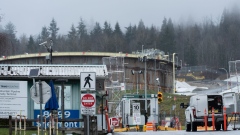May 9, 2023
Wildfires: Rystad sees Canada output down 500,000 barrels
, Bloomberg News
No major impact of Alberta wildfires on oil producers so far: Portfolio manager Rafi Tahmazian
Wildfires in Alberta may have reduced energy production by the equivalent of 500,000 barrels a day, Rystad Energy said in a report Tuesday.
The fires have shut 350,000 barrels of oil and gas production, Rystad Energy estimates with “high confidence.” Those volumes include cuts announced by companies and volumes associated with Chevron Corp.’s production from the Duvernay formation in the Fox Creek area.
A conservative estimate for Tourmaline Oil Corp.’s output loss is 130,000 barrels — about 80 per cent of which is natural gas — based on the location of gas-processing facilities in the southern and western parts of the Deep Basin.
Whitecap Resources Inc. may have curtailed 50,000 barrels, based on the fires’ impact on the Pembina Cardium, Kaybob, and Wapiti Cardium operations. Neither Tourmaline, the largest gas producer in Canada, nor Whitecap has detailed how much the fires have reduced output.
GAS PRICES RETREAT AFTER MONDAY’S SURGE (3:43 p.m.)
Alberta’s natural gas prices fell on Tuesday after a sharp rise in Monday. The AECO price dropped 13 per cent to US$1.75 per million British thermal units.
ALBERTA SEES EVACUEE, FIRE COUNTS FALLING 3:37 p.m. MT)
The number of people evacuated because of the fires has declined to 24,000 from 29,000 on Monday, according to Colin Blair, executive director for the Alberta Emergency Management Agency. There are still 88 active wildfires and 12 evacuation orders in place.
Some 24 blazes are out of control even as firefighters have made progress with help from cooler temperatures and wetter weather, Christie Tucker, information unit manager for Alberta Wildfire, said during a media briefing. But fire danger remains very high in some northern areas, and investigations are still underway to determine the cause of the wildfires, she said.
RAIN SEEN HELPING OUTPUT RECOVER (12:30 p.m. MT)
Rain headed for the areas in western Canada struck by a spate of wildfires should improve safety conditions, and production may be able to return quickly, according to Wood Mackenzie.
About 2.5 billion cubic feet per day of natural gas production — about 15 per cent of all of Canada’s output — has been shut down by the blazes, the firm said. While some oil output has been curtailed, crude pipeline operations in western Canada have been “largely unaffected,” Wood Mackenzie said.
“Based on the current location of the fires, we expect crude supply, flows, and storage levels to be significantly less affected than in May-June 2016, when widespread fires shuttered oil-sands production,” the firm said.
CANADIAN HEAVY OIL PRICES STRENGTHEN (11:40 a.m. MT)
The price of Canadian heavy oil-sands crude, which is mixed with light condensate produced in western Alberta, strengthened. Western Canadian Select’s discount to the US benchmark shrank 60 cents to $13.50 a barrel, data compiled by Bloomberg show. Condensate’s discount widened 5 cents to $3.25 a barrel. Edmonton mixed sweet crude’s discount was unchanged at $2.50 a barrel.
MILITARY IS READY TO PROVIDE CONSTRUCTION EQUIPMENT (11 a.m. MT)
Emergency Preparedness Minister Bill Blair said the Canadian Armed Forces are prepared to provide airlift resources and engineering and construction equipment as requested by Alberta.
However, he said the province also requested military resources to provide security in communities where people have been evacuated from their homes, and the federal government believes that’s primarily a policing responsibility. Blair said his government will work with the Royal Canadian Mounted Police and Alberta, including by potentially bringing in RCMP officers from other jurisdictions to help.
“The policing should be done by the police, but the Canadian Armed Forces have always been there to respond with expertise and with equipment that only they can provide,” Blair said.
SCOTIABANK SEES BLAZES TRIMMING CANADA’S GDP (9:24 a.m. MT)
The wildfires burning across Canada’s main natural gas-producing region may trim 0.2 per cent to 0.3 per cent from growth in the country’s gross domestic product in May if much of the area’s output remains shut for the month, one of Bank of Nova Scotia’s top economists estimates.
That projection is rough and could evolve as more shutdowns are announced, but the blazes “are going to be messing with the Canadian economic statistics,” Derek Holt, head of capital markets economics, said in a note to clients Tuesday.
“We’re getting into the high single-digits of Alberta’s total oil output that is being shut-in, and oil and gas is about 5.3 per cent of monthly Canadian GDP,” Holt said. “There are also effects on prices, including Alberta hub natural gas and Western Canada Select crude oil prices that have been rising as the fires and shut-ins have spread.”
Canada’s economic growth already was expected to stall in the middle of this year as rate hikes from the country’s central bank cool activity. Since the production shock is transitory, it “should not impact monetary policy as rebounds and possible rebuilding will follow,” Holt said.
ALBERTA BLAZE COUNT DECLINES (8:25 a.m. MT)
Alberta was reporting 89 active wildfires as of 8:25 a.m. Mountain time, with 27 of those out of control. That’s down from more than 100 total active fires yesterday.
Those blazes have shut down the equivalent of at least 234,000 barrels a day of oil production, sending low-sulfur sweet crude prices in Canada to a one-year high. Nearly a fifth of western Canadian natural gas supply has been suspended, prompting a surge in those prices as well.
TRUDEAU SAYS FEDERAL RESPONSE UNDER DISCUSSION (7 a.m. MT)
Prime Minister Justin Trudeau said his government had received the official request for assistance from Alberta Premier Danielle Smith and her government. Discussions are underway on how best to respond, and resources are being mobilized as quickly as possible, he said.
“Over the past number of days, federal resources have been stood up and made ready for what we expected to be a request for assistance,” Trudeau told reporters in Ottawa. “We’re going to be able to be there for the people of Alberta.”
OPERATIONAL UPDATES
Below is a summary of operational updates from companies operating in the area:
- Tidewater Midstream & Infrastructure Ltd. shut its Brazeau River Complex, a gas processing facility, west of Edmonton and evacuated all personnel, the company said in an email. The complex remains down because power hasn’t been restored to area. The Ram River gas plant that was shut on Friday is expected to resume “shortly” pending regulatory approval.
- Chevron evacuated workers located in the Fox Creek area, and the company’s operational sites have been secured.
- Paramount Resources Ltd. has shut the equivalent of about 50,000 barrels a day of oil production as of May 5 as a precaution and because of disruptions to third-party infrastructure, the company said Sunday. Its operations in the Grande Prairie and Kaybob regions are being affected.
- Keyera Corp. shut six gas plants over May 4-5, including Brazeau River, Pembina North, Zeta Creek, Cynthia, Nordegg and Wapiti gas plants.
- ARC Resources Ltd. said it has faced only minimal effects to its operations resulting from impacts to third-party pipelines and related infrastructure.
- Cenovus Energy Inc. said the equivalent of about 85,000 barrels of oil production has been affected by the fires, primarily dry gas from the company’s Rainbow Lake, Kaybob-Edson, Elmworth-Wapiti and Clearwater operating areas. The company maintained its guidance for output of 790,000 to 810,000 barrels of oil equivalent a day for the year.
- TC Energy Corp. has shut three compressor stations on its gas system due to the fire, though it continues normal operations on its NOVA Gas Transmission Ltd. System and other networks in western Canada.
- Obsidian Energy Ltd. has shut about 11,100 barrels of oil equivalent a day of output from the Pembina area in Central Alberta, down from 15,500 barrels of oil equivalent a day over the weekend, the company said in an update.
- Peyto Exploration & Development Corp. is in the process of restoring production after shutting two plants in the Brazeau area on May 5, the company said.
- Pembina Pipeline Corp. shut down the Saturn I and II gas plants north of Hinton and the Duvernay Complex, west of Fox Creek. The facilities have a combined processing capacity of 443 million cubic feet a day, net to Pembina. Related pump stations, gathering systems and supporting infrastructure are also down. Wapiti Gas Plant, KA Plant, K3 Plant and Peace Pipeline system’s 20-inch line from Fox Creek to Edmonton have resumed operation after being temporarily shut.
- Canadian Natural Resources Ltd. has temporarily shut the equivalent of about 39,000 barrels of oil production, including all sites in proximity to wildfires. Oil-sands mining operations haven’t been affected.
- Baytex Energy Corp. cut 10,000 barrels of daily oil equivalent production, with 70 per cent of the output being crude oil.
- NuVista Energy Ltd. shut about 40,000 barrels a day of production after depressurizing operations close to fires.
- Whitecap shut production near wildfires, and the company is assessing the situation’s effect on its second-quarter volumes.
- Crescent Point Energy Corp. has shut in 45,000 barrels a day of production in the Kaybob Duvernay region, though the company said it has seen no damage to its assets.
- Vermilion Energy Inc. temporarily shut 30,000 barrels a day of production, but added in a statement that initial assessments indicate minimal damage to key infrastructure.
- Pipestone Energy Corp. has shut in around 20,000 barrels a day of production.
- Tourmaline has closed down nine South and West Deep Basin gas-processing facilities as nearby fires expanded and new wildfires rapidly emerged.
- Tamarack Valley Energy Ltd. had to shut about 220 barrels a day of production after the gas-processing plants operated by other companies went out of operation due to the blazes.





